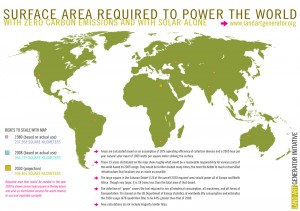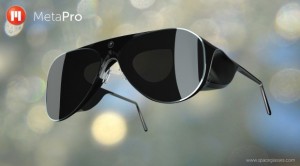 Solar panels take space, but just how much land area would need to be covered with solar panels to provide 100% of this planet’s power needs (including transportation)? The answer is pretty surprising, as the image here shows (click on it for a larger version). It helps show just how much energy the sun is sending our way, and what a small percentage of that is actually required to power our civilization.
Solar panels take space, but just how much land area would need to be covered with solar panels to provide 100% of this planet’s power needs (including transportation)? The answer is pretty surprising, as the image here shows (click on it for a larger version). It helps show just how much energy the sun is sending our way, and what a small percentage of that is actually required to power our civilization.
There’s still a matter of energy storage with solar panels, but I wonder, if long range transmission efficiency could be boosted to the point where we have a global power grid? The sun is always shining on about half the planet…if that power could be transmitted to the dark side of the planet, there would be no need to store electricity. Nikola Tesla suggested that just such a system could be possible. The drawbacks are obvious though…it would be difficult or even impossible to employ Tesla’s system in a way that would allow companies to control who uses that energy. The business model falls apart, sadly, and we live in a world controlled by business and profit.


 Shipping next June, the MetaPro glasses offer a significantly more immersive experience than Google Glass, but at a much higher cost…$3,000. You’ll wear a small computer to wirelessly communicate with the glasses, which can display full 720p HD in a 40 degree field of view. Potential applications for this all come down to software, which is a bit of a chicken and egg scenario. Nevertheless, with more products like this emerging onto the markets, I expect the software side of things to pick up pace in 2014. Meta claims their app store has 500+ apps, which is a great start even if you’re pessimistic and expect most of those to be junk.
Shipping next June, the MetaPro glasses offer a significantly more immersive experience than Google Glass, but at a much higher cost…$3,000. You’ll wear a small computer to wirelessly communicate with the glasses, which can display full 720p HD in a 40 degree field of view. Potential applications for this all come down to software, which is a bit of a chicken and egg scenario. Nevertheless, with more products like this emerging onto the markets, I expect the software side of things to pick up pace in 2014. Meta claims their app store has 500+ apps, which is a great start even if you’re pessimistic and expect most of those to be junk.
 There’s an interesting new movie hitting theaters tomorrow, called
There’s an interesting new movie hitting theaters tomorrow, called 
 McLaren
McLaren